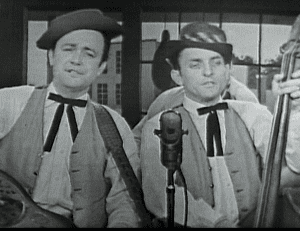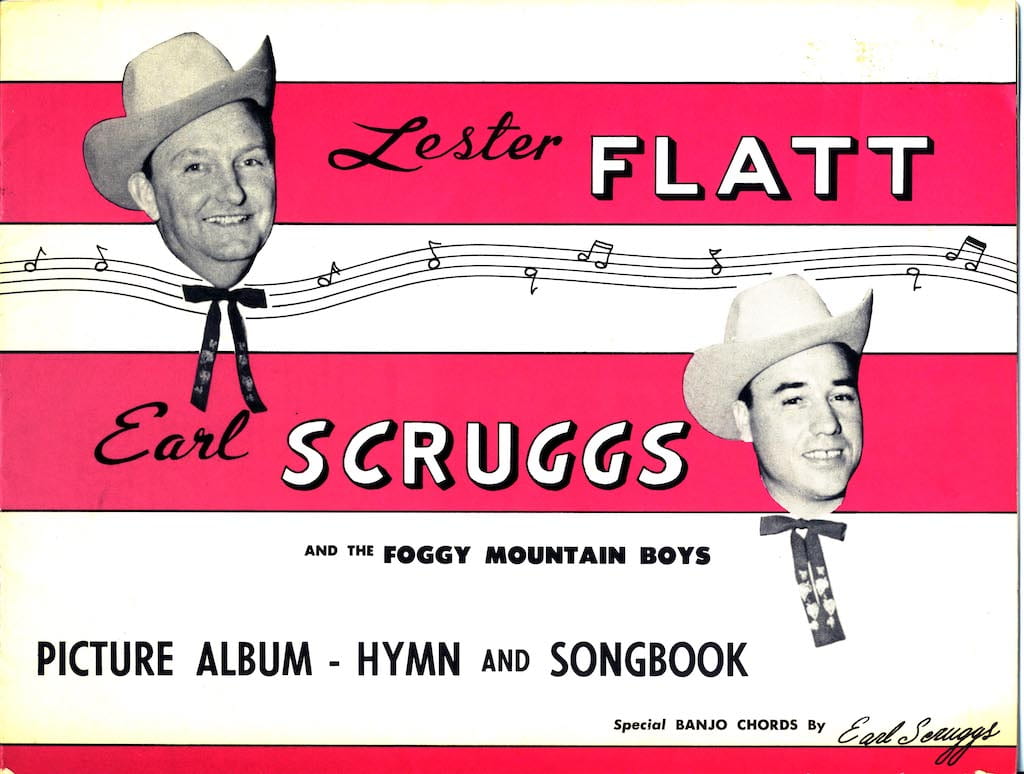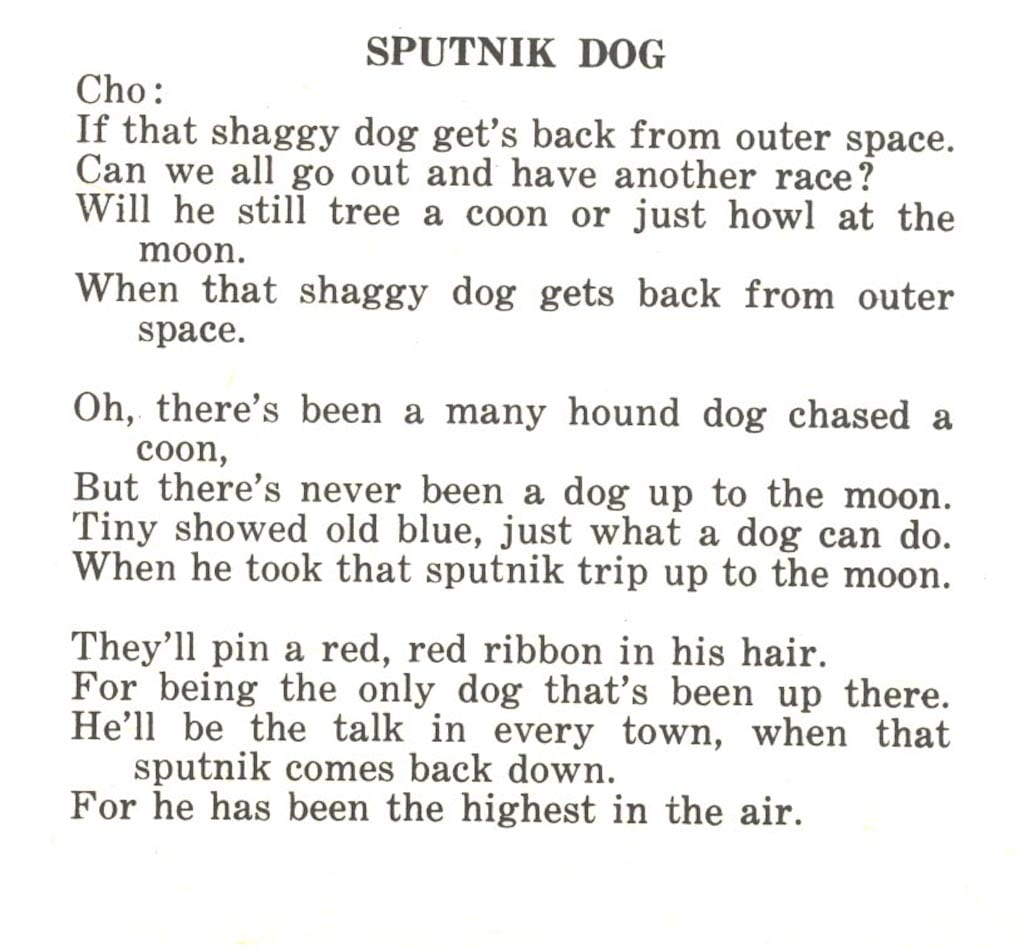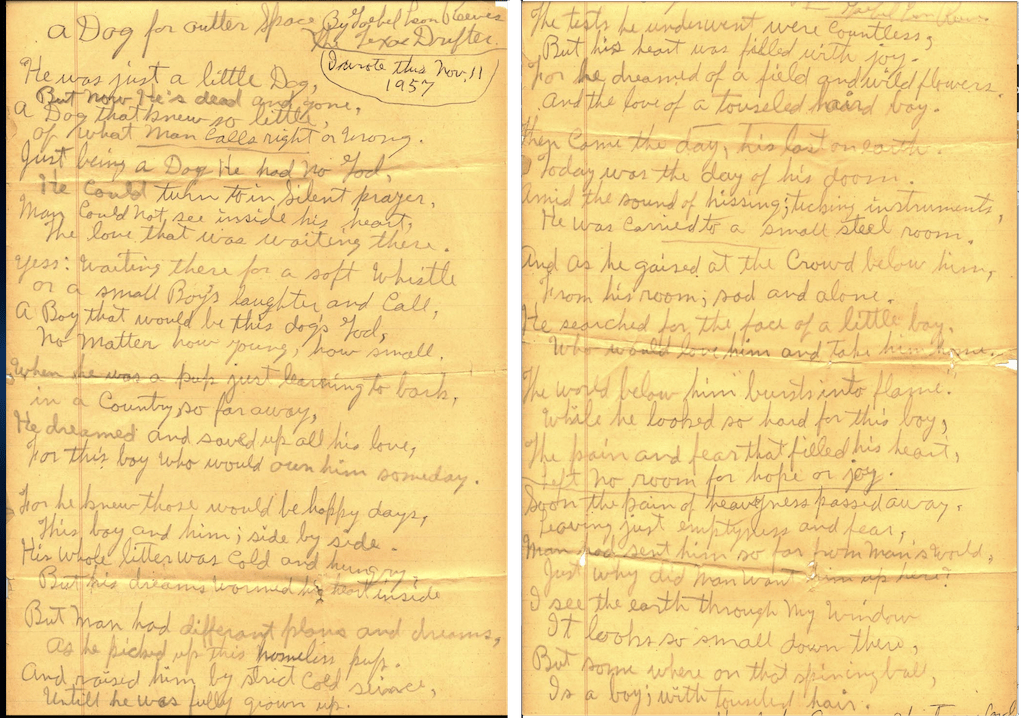Orphans in Space: Forgotten Films from the Final Frontier
special edition for Roger That! 2021
 The Flatt and Scruggs Grand Ole Opry Show
The Flatt and Scruggs Grand Ole Opry Show
(WSM-TV, 1961) 6 min., b&w, sound
excerpts featuring Jake and Josh
Source: Country Music Hall of Fame and Museum
Note: the two short excerpts on the 2012 DVD are not streamable here, but related media are integrated into the updated notes below.
Guitar-banjo duo Lester Flatt and Earl Scruggs honed their musical chops as part of Bill Monroe and the Bluegrass Boys for two years before they broke away in 1948 to form Flatt and Scruggs and the Foggy Mountain Boys. In 1953, they became popular Nashville radio regulars on WSM’s early morning Martha White Biscuit Time. After six months of live weekday broadcasts, the group recorded its fifteen-minute shows and shipped them to WSM from the road. Thanks to their popularity and Martha White sponsorship, the team became “members” of the Grand Ole Opry in 1955, performing regularly on its Nashville stage and broadcasts. Soon they were television stars of The Flatt and Scruggs Grand Ole Opry Show. The half-hour TV program aired weekly, syndicated to local stations across the South, and running until the duo split in 1969.
The tunes in these excerpts from the show feature Jake Tullock and Josh Graves of the Foggy Mountain Boys. Like all members of Flatt and Scruggs groups, both were talented string players. Graves in particular mastered the dobro (resophonic guitar), while Tullock played bass fiddle and guitar. “Cousin Jake” and “Uncle Josh,” however, were better known for their comedy segments, done in the guise of country rubes. As with their contemporary comic television characters on The Beverly Hillbillies (on which Lester and Earl appeared) and The Andy Griffith Show, the stereotypes could not disguise a sly knowledge of the modern world and accomplished musicianship.
In these New Frontier performances from 1961, Jake and Josh sing about the space race in the topical novelty songs “They’re Gonna Put a Monkey on the Moon” and “Sputnik Dog” (aka “When That Shaggy Dog Gets Back from Outer Space,” written in 1959). Flatt introduces both numbers, while Scruggs and fiddler Paul Warren provide accompaniment. The lyrics to “Monkey on the Moon” directly reference Ham, the chimpanzee NASA launched into orbit January 31, 1961. (Previously unpublished footage of Ham before and after his flight is part of the disc’s Chimp Recovery reels.) “Sputnik Dog,” written by Flatt in 1959, alludes to Laika, the canine cosmonaut aboard the Soviet Sputnik II (1957) and to the 1959 Disney film The Shaggy Dog (which opens with its protagonist building a missile interceptor and culminates with the apprehension of spies trying to steal a “hydrogen missile”). This Cold War hillbilly ditty is remarkably free from the post-Sputnik panic that permeated American culture of that moment. In fact, it practically celebrates the Red dog who “comes back from outer space.” (In fact Laika died during her flight).
Neither song appears among the many commercial recordings by Flatt and Scruggs, or anyone else. (Gene Hall’s “Monkey on the Moon” ARK 240 (1962) is his own topical rockabilly song .) Unpublished audio recordings of two undated radio performances of “When that Shaggy Dog Gets Back from Outer Space” are preserved in the Bob Carlin Collection, Southern Folklife Collection, Wilson Library, University of North Carolina at Chapel Hill. (“Bluegrass radio shows, Flatt & Scruggs,” SFC Audio Open Reel FT-20050/17506). Fan notes record that the group was performing “Shaggy Dog” in live sets in 1959.
The rare book Lester Flatt and Earl Scruggs Picture Album, Hymn and Songbook (196?) contains the lyrics to “Sputnik Dog” (as sung on the TV program).

 Illustrations from Carrie Stubblefield, “A Dog for Outer Space,” Field Trip South blog, January 12, 2010.
Illustrations from Carrie Stubblefield, “A Dog for Outer Space,” Field Trip South blog, January 12, 2010.
Jaimie Vermillion, “Another Dog in Outer Space Song,” July 28, 2010, documents another Laika-inspired folk song that predates Flatt’s number. Singer-songwriter Goebel Reeves (1899-1959) wrote these sad, sentimental lines a week after the dog’s death. He imagines a dog (male) longing for an imagined boy who would love him. But the verse is remarkably existential.
. . . he’s dead and gone . . . Being a dog he had no God he could turn to. . . His whole litter was cold and hungry. Man picked up this homeless pup and raised him by strict cold science. Today was the day of his doom. The world below him burst into flame. The pain and fear that filled his heart left no room for hope or joy. Just why did man want him up here?

—
Kelli Shay Hix, Curator of Moving Images, Country Music Hall of Fame and Museum, provided research for these notes by Dan Streible. Walter Forsberg interned at the CMHOF with Hix in 2009. His work on the Hank Snow Collection led to his 2010 NYU MIAP master’s thesis “Averting the Lost Highway: Archival Advocacy and Migration Strategies for the Country Music Hall of Fame and Museum’s 1-inch Type C Videotape Materials.”
Preservation note
The archive of the Country Music Hall of Fame and Museum holds original 16mm kinescopes of 36 televised episodes of The Flatt and Scruggs Grand Ole Opry Show. Although hundreds of episodes aired during the program’s 1955-1969 run, all were presumed lost until 1989, when retired advertising executive William Graham found 24 films in his private holdings. After the museum announced the acquisition, an anonymous donor gave 12 other filmed episodes. The warped and shrunken prints required extensive restoration. After rights were cleared, in 2007 the Country Music Foundation and Shanachie Entertainment released a ten-volume DVD series, Best of the Flatt and Scruggs TV Show: Classic Bluegrass from 1956 to 1962. Volume 7 includes a segment about the preservation and restoration work done by the museum’s archivists.
The recovery of these Flatt and Scruggs programs illustrates the peculiar distinctions between the roles that film and videotape played in early television. Initially, The Flatt and Scruggs Grand Ole Opry Show was broadcast live from wherever the bluegrass stars were touring. Then, as band member Curly Seckler recollected, “videotape came along and we danced a little jig because then we could tape them here in Nashville and send them out to the stations.” When 2-inch Quad videotape reached the market in 1956, the shows were recorded on the new format. The cast performed at WSM-TV studios in Nashville, often recording material for four episodes in a single day. Producers then re-recorded the video playback on film. Local stations received the edited half-hour kinescopes for broadcast, then returned them to Nashville.
It should be noted, however, that a pair of original Quad videotapes survived erasure and were donated to the American Folklife Center at the Library of Congress in 1979. Cataloged in the Martha White Flour Show Collection as The Flatt & Scruggs Show, nos. 383 and 384, these two episodes, shot in color in 1968, feature guests Johnny Cash, June Carter Cash, and Carl Perkins. This modest video preservation work escaped the attention of fans and collectors, who celebrated the film bonanza the Country Music Hall of Fame and Museum announced a decade later.
The items as catalogued in the museum’s online database indicate the two kinescopes sources for the performances on Orphans in Space were digitized in 2016 from BetaSP video copies. Country Music Hall of Fame and Museum Digital Collections catalog lists 38 items from the FASGOOS. Items “restricted to only allow viewing of the metadata.”
Flatt And Scruggs Grand Ole Opry, Show #18. 1960s. Tullock and band perform “They’re Gonna Put A Monkey On The Moon.”
Flatt And Scruggs Grand Ole Opry, Show #48. 1961. Josh Graves and Jake Tullock perform “When That Shaggy Dog Gets Back From [Outer] Space” and do a comedy bit.
Among the streamable archival material related to Flatt and Scruggs is this audio:
https://digi.countrymusichalloffame.org/digital/collection/musicaudio/id/12033/rec/1
A radio broadcast of the Grammy Awards from Nashville, March 12, 1969. Ralph Emery and Teddy Bart, WSM hosts, talk about Lester and Earl splitting up. Johnny Cash accepts the Grammy on behalf of the absent Flatt and Scruggs. They won the award for Best Country Performance, Duo Or Group – Vocal Or Instrumental of 1968 for “Foggy Mountain Breakdown,” first recorded twenty years earlier. The success of the 1967 film Bonnie and Clyde generated a bluegrass resurgence. The Flatt and Scruggs LP The Story of Bonnie and Clyde (Columbia, 1968) included a new rendition of the Breakdown. In unprecedented fashion, both their 1949 and 1968 recordings were on the Billboard charts simultaneously.
Here’s an episode from The Flatt and Scruggs Grand Ole Opry Show (ca. 1961) of the same vintage as that seen on the DVD. Josh dobro solo at 13:20, followed by Jake and Josh with Earl singing the “old time” standard “Good Old Mountain Dew.”
The Country Music Hall of Fame and Museum’s YouTube channel has been producing new content in the Covid era. Here’s a socially-distant live performance of Bill Monroe’s “Blue Moon of Kentucky” by Marty Stuart (playing Flatt’s 1950 Martin guitar), Ricky Skaggs (on Monroe’s 1923 Gibson mandolin), and Alison Brown (Scruggs’ 1930 Gibson banjo). Recorded October 28, 2020.
https://youtu.be/jWxNdF-oUU4?t=9
Pingback: Lester Flatt's 1942 Martin D-18 - Bluegrass Today
Pingback: ≫ Lester Flatt Martin D-18 #81197 |